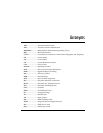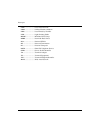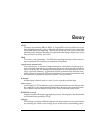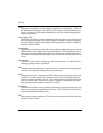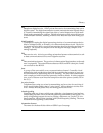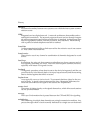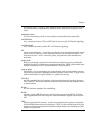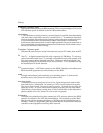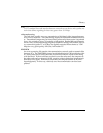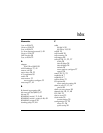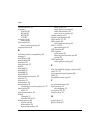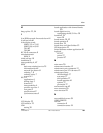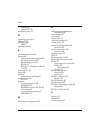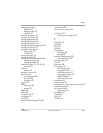
Glossary
104 ISU 512 User Manual 61202.086L1-1
S interface S reference point
The interface that connects an ISDN terminal (TEI) or terminal adapter (TA) to the
NT2 reference point as defined in the I.411 Recommendation.
synchronous
1. The condition occurring when two events happen in a specific time relationship
with each other, both under control of a master clock. 2. A method of data trans-
mission requiring the transmission of timing pulses to keep the sender and receiv-
er synchronized in their communication used to send blocks of information.
Synchronous data transmission is used in high speed data circuits because there is
less overhead than asynchronous transmission of characters which contain two ex-
tra bits per character to affect timing.
T interface T reference point
Performs the same function as the S interface but uses an NT1 rather than an NT2.
T1
Also T-1. A digital transmission link with a capacity of 1.544 Mbps. T1 uses two
pairs of normal twisted wires. T1 normally can handle 24 voice conversations with
each conversation being digitized at 64 kbps. With more advanced digital voice
encoding techniques, it can handle more voice channels. T1 is a standard for dig-
ital transmission in North America.
TA
Terminal adaptor. A DCE that connects to the ISDN S-Interface and enables non-
ISDN terminal equipment to communicate over the ISDN.
trunk
A single transmission path connecting two switching system. Trunks can be
shared by many users, but serve only one call at a time.
two-wire circuit
A transmission circuit composed of two wires, signal and ground, used to both
send and receive information. In contrast, a 4-wire circuit consists of two pairs.
One pair is used to send. One pair is used to receive. All trunk circuits (long dis-
tance) are 4-wire. A 4-wire circuit delivers better reception, but also costs more.
All local loop circuits (those coming from a Class 5 central office to the subscriber’s
phone system) are 2-wire, unless a 4-wire circuit is requested.
U-Interface
A twisted pair subscriber loop that connects the NT1 reference point to the ISDN
network, as defined in the I.411 Recommendation. This interface provides Basic
Rate Access with an operating frequency of 160 kbps and an information rate of
144 kbps. Under U.S. regulations, this also marks the line of demarcation between
customer-owned equipment and the public network.




